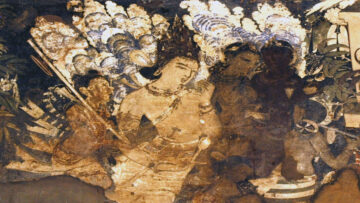George Weston Briggs has undertaken a meticulous endeavor to comprehensively cover the various functional and cultural aspects of the Doms, a community spread across the diverse landscape of India. His exploration delves deeply into the intricate details of essential rituals and ceremonies associated with the different stages of life, including birth, life itself, and even death. The resulting work, titled “The Dom and Their Near Relations,” emerges as an exceptional publication, as few books exist that offer such an all-encompassing and detailed portrayal of a single community.
What distinguishes this book is the evident dedication and extensive research that serve as the foundation for its intricate chapters. The content unfolds in a carefully arranged chronological sequence, commencing with explorations of theories and legends, moving through various phases of existence, including birth and life, and culminating in the exploration of metaphysical and transcendental dimensions.
The opening chapter of the book functions as a preliminary lens through which the remainder of the content is viewed. In this chapter, the author casts light on the Cāndala Doms, highlighting instances where this term has been used, and providing anecdotal stories that shed further illumination. Additionally, the chapter delves into the divisions and social hierarchies within the Doms, supported by well-regarded literary sources.
The following chapter, labeled “Contemporary Beliefs About Their Own Origin,” brings to the fore a fundamental connection between the Doms and other marginalized groups, such as tribes and gypsies scattered across India. The author embarks on a journey tracing the roots of the Doms’ lineage, leading back to their earliest ancestor. Throughout this exploration, the recurrent name of Supach emerges as a central thread, weaving a tapestry of ancestral connections. The narratives further intertwine with stories related to significant figures like Lord Shiva and Raja Harishchandra, adding depth and cultural resonance.
In the subsequent chapter, titled “The Dom Group,” the author provides in-depth insights into the intricate divisions existing within the Dom community throughout the Indian subcontinent. The exploration encompasses well-known Dom Groups, including Maghaiya, Harcānni, Namasudra, Bansphors, and Dhanuks, as well as related subdivisions that have evolved due to geographical and linguistic variations.
Transitioning into “The Dom Today,” the book takes on a comparative lens, juxtaposing historical conditions with contemporary perceptions of the Dom community. This examination covers various aspects, including physical attributes, social status, general appearances, demeanor, and habits, offering a nuanced understanding of the evolution of the Dom identity over time.
In a subsequent chapter titled “Social Organization or Structure,” readers are granted a profound glimpse into the social framework and functioning of distinct Dom Groups. This exploration begins with an examination of the processes involved in recruiting members to these groups, followed by an investigation of regulatory and welfare measures. A particular spotlight is cast on the All India Shraddhaanand Dalituddhar Sabha of Delhi, and the chapter extends to encompass insights into the Dom’s unique judicial system for addressing minor issues, which relies on their panchayats rather than formal legal institutions.
The theme of “Struggle for Existence” unfolds across two interconnected chapters. These chapters delve into factors that have exacerbated the economic challenges faced by the Dom community. The concept of jajmani rights, encompassing inherited privileges, and the begar principle, symbolizing economic servitude and exploitation, come under scrutiny. These intertwined concepts are rooted in customary duties that are considered hereditary rights. The subsequent chapter elaborates on this theme, further emphasizing the intricate interplay between criminality and poverty as the Dom community navigates their pursuit of survival.
Further chapters delve into the rich tapestry of Dom life, including “Birth Customs,” which provides insights into post-birth ceremonies within different Dom groups. Notably, these groups share the absence of prescribed prenatal ceremonies and share the practice of shaving a child’s head upon birth, often performed at the Devi shrine in Vindhyachal (Mirzapur).
The subsequent chapters, “Marriage Customs” and “The Marriage Rituals and Their Settings,” immerse readers in the distinct marriage rituals observed by various Dom groups. Of note is the involvement of Brahmins ostracized by their own community in officiating marriages. While child marriage is prohibited, the Doms often arrange marriages soon after puberty, with principles like endogamy and exogamy reflecting their flexible social structure.
The chapter titled “Disposal of the Dead” sheds light on the occupational aspects of the Doms, particularly those residing in Banaras. The chapter encompasses both the rites and customs associated with the passing of a Dom community member and their role in the death rituals of individuals from other castes. While some unique elements are present, the rites largely mirror those practiced within the broader Hindu community.
Under “Other Domestic Customs,” readers gain insights into the operational dynamics of Dom groups. This section explores their employment statuses, social interactions, and residential arrangements, providing a comprehensive perspective on their way of life.
The narrative then turns to the metaphysical and spiritual dimensions of the Doms, delving into their beliefs in benevolent and malevolent spirits, referred to as ancestors and heroes. These chapters also encompass their veneration of deities and natural objects, shedding light on the intricate weave of spirituality within the community.
In its entirety, “The Dom and Their Near Relations” seeks to encapsulate the essence of Dom life through a vibrant and intricate lens. While it succeeds admirably in this endeavor, the book’s scope could potentially have been expanded to encompass topics such as economic and political relationships, making it even more comprehensive and setting a higher benchmark for similar works. Nevertheless, the book establishes a firm foundation and a substantial body of research that will undoubtedly inform and inspire future scholarly pursuits.
Disclaimer: The opinions expressed in this article belong to the author. Indic Today is neither responsible nor liable for the accuracy, completeness, suitability, or validity of any information in the article.








